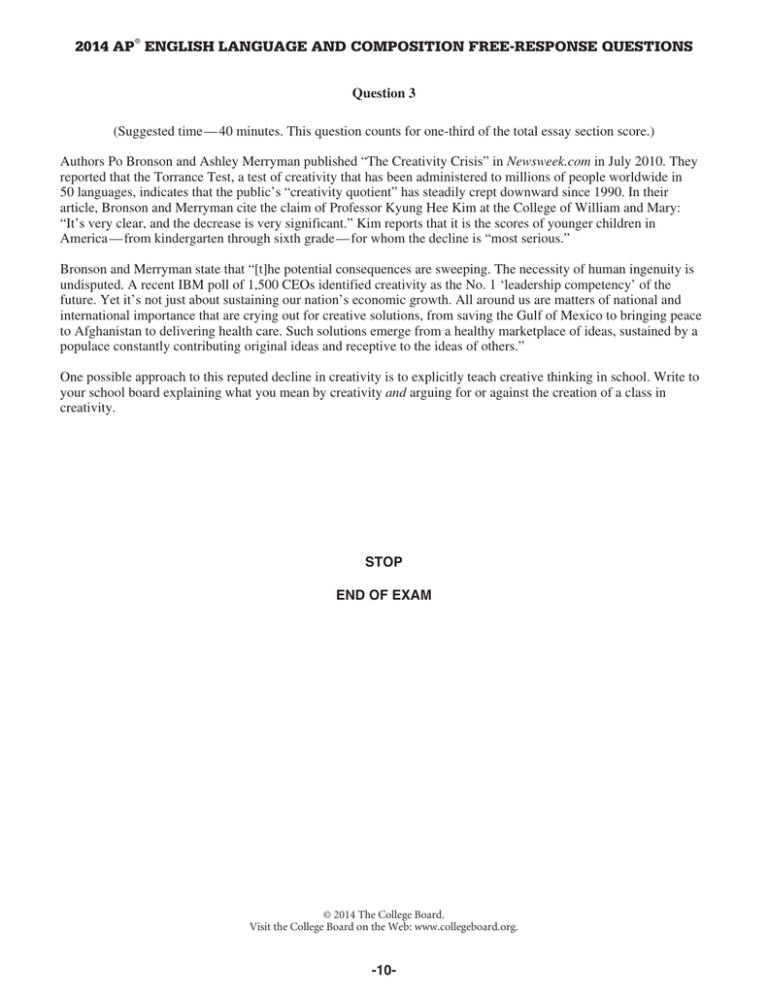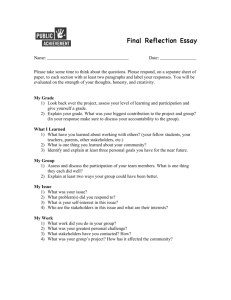2014 AP® ENGLISH LANGUAGE AND COMPOSITION FREE
advertisement

2014 AP® ENGLISH LANGUAGE AND COMPOSITION FREE-RESPONSE QUESTIONS Question 3 (Suggested time—40 minutes. This question counts for one-third of the total essay section score.) Authors Po Bronson and Ashley Merryman published “The Creativity Crisis” in Newsweek.com in July 2010. They reported that the Torrance Test, a test of creativity that has been administered to millions of people worldwide in 50 languages, indicates that the public’s “creativity quotient” has steadily crept downward since 1990. In their article, Bronson and Merryman cite the claim of Professor Kyung Hee Kim at the College of William and Mary: “It’s very clear, and the decrease is very significant.” Kim reports that it is the scores of younger children in America—from kindergarten through sixth grade— for whom the decline is “most serious.” Bronson and Merryman state that “[t]he potential consequences are sweeping. The necessity of human ingenuity is undisputed. A recent IBM poll of 1,500 CEOs identified creativity as the No. 1 ‘leadership competency’ of the future. Yet it’s not just about sustaining our nation’s economic growth. All around us are matters of national and international importance that are crying out for creative solutions, from saving the Gulf of Mexico to bringing peace to Afghanistan to delivering health care. Such solutions emerge from a healthy marketplace of ideas, sustained by a populace constantly contributing original ideas and receptive to the ideas of others.” One possible approach to this reputed decline in creativity is to explicitly teach creative thinking in school. Write to your school board explaining what you mean by creativity and arguing for or against the creation of a class in creativity. STOP END OF EXAM © 2014 The College Board. Visit the College Board on the Web: www.collegeboard.org. -10- AP® ENGLISH LANGUAGE AND COMPOSITION 2014 SCORING GUIDELINES Question 3 The score should reflect the essay’s quality as a whole. Remember that students had only 40 minutes to read and write; the essay, therefore, is not a finished product and should not be judged by standards appropriate for an out-of-class assignment. Evaluate the essay as a draft, making certain to reward students for what they do well. All essays, even those scored 8 or 9, may contain occasional lapses in analysis, prose style, or mechanics. Such features should enter into a holistic evaluation of an essay’s overall quality. In no case should an essay with many distracting errors in grammar and mechanics score higher than a 2. _______________________________________________________________________________________ 9 – Essays earning a score of 9 meet the criteria for the score of 8 and, in addition, are especially sophisticated in their argument, thorough in their development, or particularly impressive in their control of language. 8 – Effective Essays earning a score of 8 effectively explain what the writer means by creativity and argue for or against the creation of a class in creativity. The evidence and explanations used are appropriate and convincing, and the argument* is especially coherent and well developed. The prose demonstrates a consistent ability to control a wide range of the elements of effective writing but is not necessarily flawless. 7 – Essays earning a score of 7 meet the criteria for the score of 6 but provide a more complete explanation, more thorough development, or a more mature prose style. 6 – Adequate Essays earning a score of 6 adequately explain what the writer means by creativity and argue for or against the creation of a class in creativity. The evidence and explanations used are appropriate and sufficient, and the argument is coherent and adequately developed. The writing may contain lapses in diction or syntax, but generally the prose is clear. 5 – Essays earning a score of 5 explain what the writer means by creativity and argue for or against the creation of a class in creativity. The evidence or explanations used may be uneven, inconsistent, or limited. The writing may contain lapses in diction or syntax, but it usually conveys the writer’s ideas. 4 – Inadequate Essays earning a score of 4 inadequately explain what the writer means by creativity and argue for or against the creation of a class in creativity. The evidence or explanations used may be inappropriate, insufficient, or unconvincing. The argument may have lapses in coherence or be inadequately developed. The prose generally conveys the writer’s ideas but may be inconsistent in controlling the elements of effective writing. 3 – Essays earning a score of 3 meet the criteria for the score of 4 but demonstrate less success in explaining what the writer means by creativity and arguing for or against the creation of a class in creativity. The essays may show less maturity in control of writing. © 2014 The College Board. Visit the College Board on the Web: www.collegeboard.org. AP® ENGLISH LANGUAGE AND COMPOSITION 2014 SCORING GUIDELINES Question 3 (continued) 2 – Little Success Essays earning a score of 2 demonstrate little success in explaining what the writer means by creativity and arguing for or against the creation of a class in creativity. These essays may demonstrate misunderstanding of the prompt, or substitute a simpler task by responding to the prompt tangentially with unrelated, inaccurate, or inappropriate explanation. The prose often demonstrates consistent weaknesses in writing, such as grammatical problems, a lack of development or organization, or a lack of coherence and control. 1 – Essays earning a score of 1 meet the criteria for the score of 2 but are undeveloped, especially simplistic in their explanation and argument, weak in their control of language, or especially lacking in coherence. 0 – Indicates an off-topic response, one that merely repeats the prompt, an entirely crossed-out response, a drawing, or a response in a language other than English. — Indicates an entirely blank response. * For the purposes of scoring, argument means asserting a claim justified by evidence and/or reasoning © 2014 The College Board. Visit the College Board on the Web: www.collegeboard.org. ©2014 The College Board. Visit the College Board on the Web: www.collegeboard.org. ©2014 The College Board. Visit the College Board on the Web: www.collegeboard.org. ©2014 The College Board. Visit the College Board on the Web: www.collegeboard.org. ©2014 The College Board. Visit the College Board on the Web: www.collegeboard.org. ©2014 The College Board. Visit the College Board on the Web: www.collegeboard.org. ©2014 The College Board. Visit the College Board on the Web: www.collegeboard.org. AP® ENGLISH LANGUAGE AND COMPOSITION 2014 SCORING COMMENTARY Question 3 Overview Question 3, the argument question, begins by recounting a research claim that the “creativity quotient” of American young people, particularly those in kindergarten through sixth grade, has declined. Students were asked to consider this claim in the context of looming, unprecedented global crises that require creative responses (e.g., pollution in the Gulf of Mexico and the war in Afghanistan). Finally, students were asked to consider whether one particular attempt to solve the creativity crisis — adding a separate class in creativity — was a viable solution for their own schools to implement. In an effort to help students focus and address their arguments to an audience with the capacity to take action, the prompt asked students to address their arguments to their school boards. Because specifying an audience was intended to help students respond successfully to the prompt, not to give them a way to fail, students were not penalized for not writing in the form of a letter or for not explicitly addressing their arguments to their school boards. While some students had a clear understanding of who makes up their school boards and how school boards function, others did not. So while some students may have been rewarded in the scoring for skillfully employing rhetorical strategies such as appealing to shared values such as quality education, community involvement, and finding solutions to global problems, students were not penalized for failing to use these strategies. The question was intended to give students an opportunity to demonstrate their abilities to produce sound and convincing arguments in support of clearly articulated positions. Unlike some previous argument questions, this year’s prompt gave students an either/or choice — to argue for or against establishing a creativity class in their school’s curriculum. Unlike prompts that required students to build arguments about abstract concepts (e.g., last year’s argument prompt about the relationships between ownership and sense of self), this year’s prompt explicitly directed students to supply their own definitions of “creativity.” This explicit direction was intended to underscore the importance in argumentation of defining terms that might otherwise be interpreted differently by audience members. Sample: 3A Score: 8 This essay convincingly and purposefully develops the argument that creativity ought not to be the subject of a specific class, proposing instead that “the value of creative thinking should be implemented into classes themselves.” The student first defines creativity as a process of developing new ideas, applying them, and adapting them to different circumstances, then continues by making the point that creativity “should be taught as being a fluid process, one that seamlessly integrates into such a wide range of applications, not as one that is a separate process altogether.” The essay establishes a well-articulated line of reasoning, acknowledging an alternative position and effectively using a personal example to support its position. It aptly elaborates that, in the student’s middle school class on “Creative Thinking,” the creative process that was taught “was not referenced and reinforced in my other classes, making it difficult for me to make the connection of how creativity could be applied to more traditional subjects.” This essay earned a score of 8 for its especially coherent argument and its consistent ability to control a wide range of the elements of effective writing. © 2014 The College Board. Visit the College Board on the Web: www.collegeboard.org. AP® ENGLISH LANGUAGE AND COMPOSITION 2014 SCORING COMMENTARY Question 3 (continued) Sample: 3B Score: 4 This essay asserts the need for a class devoted to instruction that would foster creativity. It attempts to provide a definition of creativity, but in doing so, relies on examples of creative fields and accomplishments (the “Lincoln Memorial, Vietnam Veterans Memorial, the Washington monument”) rather than developing a definition that might be used to develop an argument for creating a class. The argument inadequately explains the kind of classroom instruction that will produce the accomplishments proposed, the particular creative achievements that are said to be crucial, or the particular fields associated with creativity. Consisting mainly of general and vague assertions (“If we do not save the children of our country now, they will not be able to save us in the future”), this essay earned a score of 4. Sample: 3C Score: 2 This essay attempts to define creativity (“Creativity starts from what you think and how you express yourself”) but demonstrates little success in arguing for or against the creation of a class in creativity. Each sentence in this essay makes a somewhat reasonable point, though often too generally or vaguely. The essay does not express a clear position on whether or not a class in creativity should be created. The essay as a whole lacks development, organization, and control, and therefore it earned a score of 2. © 2014 The College Board. Visit the College Board on the Web: www.collegeboard.org. 2011 AP® ENGLISH LANGUAGE AND COMPOSITION FREE-RESPONSE QUESTIONS (Form B) Question 3 (Suggested time—40 minutes. This question counts for one-third of the total essay section score.) American essayist and social critic H. L. Mencken (1880–1956) wrote, “The average man does not want to be free. He simply wants to be safe.” In a well-written essay, examine the extent to which Mencken’s observation applies to contemporary society, supporting your position with appropriate evidence. END OF EXAM © 2011 The College Board. Visit the College Board on the Web: www.collegeboard.org. -10-



